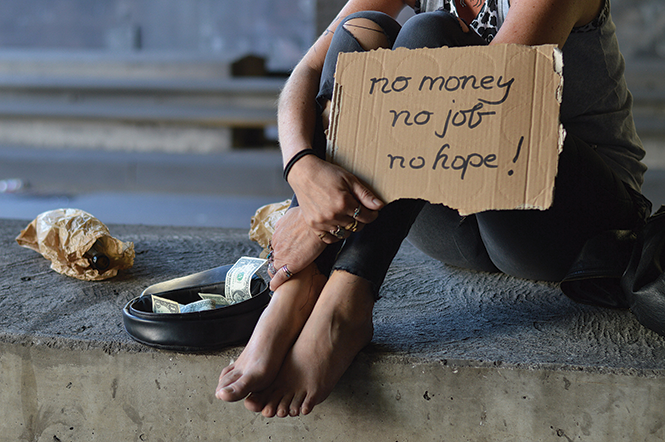Since 1976, Project Censored’s role has been to shed light on the most significant news that’s somehow not fit to print. As previously noted in Part 1 of this series (published Dec. 24), censorship in an authoritarian society is obvious, from a distance, at least. There is a central agent or agency responsible for it, and the lines are clearly drawn. That’s not the case in America, yet some stories rarely, if ever, see the light of day. The media erasure is part of a system of targeting and marginalization. While journalists everyday work hard to expose injustices, they work within a system where some injustices are so deeply baked in that stories exposing them are rarely told and even more rarely expanded upon to give them their proper due.
That’s where Project Censored comes in.
“The primary purpose of Project Censored is to explore and publicize the extent of news censorship in our society by locating stories about significant issues of which the public should be aware, but is not, for a variety of reasons,” wrote its founder Carl Jensen on its 20th anniversary.
Thus, the list of censored stories that’s the centerpiece of its annual book, State of the Free Press 2021, doesn’t just help us to see individual stories we might otherwise have missed. It helps us see patterns—patterns of censorship and suppressed stories, and patterns of how those stories fit together.
In Part I, published in City Weekly’s Dec. 24 issue, the Top 10 list also included: Missing and Murdered Indigenous Women and Girls (MMIWG), the targeting of journalists and activists by Monsanto “Intelligence Center, and how the U.S. Military is a massive, hidden contributor to climate crisis. In Part III, to be published on Jan. 7, you’ll read about the underreporting of missing and victimized Black women and girls, the public banking revolution, how climate change is increasing the risks of nuclear power and how journalism is due for a stimulus package and public option.
These stories are only part of what Project Censored does. The book’s other chapters are devoted to other forms of obfuscation that help keep censored stories obscured. You’ll read a chapter on “Junk Food News”: cheaply produced, stories focused on celebrityhood, industry-generated buzz and other trivia in place of substantive investigative journalism, and another devoted to “News Abuse,” about important topics that are presented through a distorted lens or two. There’s also a chapter devoted to “Déjà Vu News,” tracking previous Project Censored stories to update them and track whether they’ve gained some of the wider attention they deserve. And the chapter “Media Democracy in Action” highlights individuals and organizations engaged in building a more inclusive, equitable and democratic society.
Should these summaries leave you hungry for more, Project Censored has all that and more waiting for you in State of the Free Press 2021.

Congressional Investments and Conflicts of Interest
Exposition, political corruption and conflicts of interest are age-old staples of journalism. So, it’s notable that two of the most glaring, far-reaching examples of congressional conflicts of interest in the Trump era have been virtually ignored by corporate media: Republicans’ support for the 2017 Tax Cuts and Jobs Act and a bipartisan failure to act on catastrophic climate change.
“The cuts likely saved members of Congress hundreds of thousands of dollars in taxes collectively, while the corporate tax cut hiked the value of their holdings,” writes Peter Cary of the Center for Public Integrity reported for Vox in January 2020.
It was sold as a middle-class tax cut that would benefit everyone. “Promises that the tax act would boost investment have not panned out,” he noted. “Corporate investment is now at lower levels than before the act passed, according to the Commerce Department.”
Once again, “trickle down” tax cuts didn’t trickle down. “The tax law’s centerpiece is its record cut in the corporate tax rate, from 35 percent to 21 percent,” Cary wrote. “At the time of its passage, most of the bill’s Republican supporters said the cut would result in higher wages, factory expansions and more jobs. Instead, it was mainly exploited by corporations, which bought back stock and raised dividends.”
Buybacks exceeded $1 trillion for the first time ever, the year after the cuts were passed, and dividends topped a record $1.3 trillion high.
The benefits to congressional Republicans were enormous. “The 10 richest Republicans in Congress in 2017 who voted for the tax bill held more than $731 million in assets, almost two-thirds of which were in stocks, bonds, mutual funds and other instruments,” Cary noted. And they benefitted handsomely from their votes that “doled out nearly $150 billion in corporate tax savings in 2018 alone,” he wrote. “All but one of the 47 Republicans who sat on the three key committees overseeing the drafting of the tax bill own stocks and stock mutual funds.”
While Democrats also stood to gain from the tax bill, not one voted for it, he wrote. “All but 12 Republicans voted for the tax bill.”
Two special features deserve notice. First is a newly created 20% deduction for income from “pass-through” businesses, or smaller, single-owner corporations. “At least 22 of the 47 members of the House and Senate tax-writing committees have investments in pass-through businesses,” Project Censored noted.
Second was a provision allowing real estate companies with relatively few employees—like the Trump organization—to take a 20 percent deduction usually reserved for larger businesses with sizable payrolls. “Out of the 47 Republicans responsible for drafting the bill, at least 29 held real estate interests at the time of its passage,” Project Censored pointed out.
As to the second major conflict, “Members of the U.S. Senate are heavily invested in the fossil fuel companies that drive the current climate crisis, creating a conflict between those senators’ financial interests as investors and their responsibilities as elected representatives,” Project Censored wrote.
“Twenty-nine U.S. senators and their spouses own between $3.5 million and $13.9 million worth of stock in companies that extract, transport or burn fossil fuels, or provide services to fossil fuel companies,” Donald Shaw reported for Sludge in September 2019.
While unsurprising on the Republican side, this also includes two key Democrats. Sen. Tom Carper, of Delaware, is the top Democrat on the Environment and Public Works Committee. He has “up to $310,000 invested in more than a dozen oil, gas, and utility companies, as well as mutual funds with holdings in the fossil fuel industry,” Shaw reported.
But his record is not nearly as questionable as Sen. Joe Manchin’s, of West Virginia, the ranking member of the Senate Energy and Natural Resources Committee, who “owns between $1 million and $5 million worth of non-public stock in a family coal business, Enersystems,” and reported earning “between $100,001 and $1 million” in reported dividends and interest in 2018, plus $470,000 in ‘ordinary business income,'” Shaw reported.
His support for the industry was significant, as the report notes: “Manchin was the only Democrat to vote against an amendment to protect the Arctic National Wildlife Refuge from oil drilling in 2017, and he was one of just three Democrats to vote against an amendment to phase out taxpayer subsidies for coal, oil and gas producers in 2016. Manchin has also voted to approve construction of the Keystone XL oil pipeline, expedite the approval process for natural gas pipelines and override an Obama administration rule requiring coal companies to protect groundwater from toxic coal mining waste.”
While there has been critical coverage of 2017 tax cuts, this has not included coverage of lawmakers personal profiting, Project Censored noted. “In addition, despite the significant conflicts of interest exposed by Donald Shaw’s reporting for Sludge, the alarming facts about U.S. senators’ massive investments in the fossil-fuel industry appear to have gone completely unreported in the corporate press.”

Inequality Kills: Gap between Richest and
Poorest Americans Largest in 50 Years
“In public health, decades of research are coming to a consensus: Inequality kills,” DePaul University sociologist Fernando De Maio wrote for Truthout in December 2019.
Even before COVID-19, his research added fine-grained evidence of broad trends highlighted in three prominent governmental reports: the gap between rich and poor Americans had grown larger than ever in half a century, according to the U.S. Census Bureau’s 2019 annual survey. There is dramatic evidence of the gap’s lethal impact: people in the poorest quintile die at twice the rate as those in the richest quintile, according to a report by the congressional Government Accountability Office. This is partly because job-related deaths are increasingly rooted in the physical and psychological toll of low-wage work—as opposed to on-the-job accidents—as documented by the United Nations’ International Labor Organization.
All these conditions were made worse by COVID-19, but they could have been seen before the pandemic struck—if only the information hadn’t been censored by the corporate media.
As of May 2020, Project Censored notes “it has not been able to identify any corporate news coverage on the GAO or Census Bureau reports on inequality and premature mortality, or on the ILO report about work-related illnesses, accidents and deaths that take place when workers are off-duty.”
The August 2019 GAO report was based on health and retirement surveys conducted by the Social Security Administration in 1992 and 2014, looking at those between 51 and 61 years old in 1992, and dividing them into five wealth quintiles.
The GAO found that “nearly half of those (48 percent) in the poorest quintile died before 2014, when they would have been between 73 and 83 years old. Of the wealthiest quintile, only a quarter (26 percent) died,” Patrick Martin writes for the World Socialists website.
Death rates increased for each quintile as the level of wealth declined. It’s at the level of cities and communities “that the most striking links between inequality and health can be detected,” De Maio wrote. “At the city level, life expectancy varies from a low of 71.4 years in Gary, Indiana, to a high of 84.7 in Newton, Massachusetts—a gap of more than 13 years.”
And at the community level, “In Chicago,” De Maio notes, “there is a nine-year gap between the life expectancy for Black and white people. This gap amounts to more than 3,000 ‘excess deaths'” among Black Chicagoans, due to “heart disease, cancer, stroke, diabetes and kidney disease. All of these are conditions that an equitable health care system would address,” he concluded.
“The poorest Americans are also more likely than their rich counterparts to face illness or premature death due to the inherent dangers of low-wage work,” Project Censored noted.
“In 2019, you no longer have to hang from scaffolding to risk your life on the job,” María José Carmona wrote for Inequality.org. “Precariousness, stress and overwork can also make you sick, and even kill you, at a much higher rate than accidents.”
She reported on an ILO story that found that less than 14 percent of the 7500 people who die “due to unsafe and unhealthy working conditions every day” die from workplace accidents.
The greatest risk comes from “increasing pressure, precarious contracts and working hours incompatible with life, which, bit by bit, continue to feed the invisible accident rate that does not appear in the news,” Carmona wrote. “The most vulnerable workers are those employed on a temporary or casual basis, those subcontracted through agencies and the false self-employed. ILO data shows the rate of accidents for these employees to be much higher than for any others.”
As of May 2020, Project Censored has not been able to identify any corporate news coverage on the GAO or Census Bureau reports on inequality and premature mortality, or on the ILO report about work-related illnesses, accidents and deaths that take place when workers are off-duty.

Shadow Network of Conservative Outlets Emerges to Exploit Faith in Local News
In late October 2019, Carol Thompson reported in the Lansing State Journal that, “Dozens of websites branded as local news outlets launched throughout Michigan this fall … promising local news but also offering political messaging.” The websites’ ‘About us’ sections “say they are published by Metric Media LLC, a company that aims to fill the ‘growing void in local and community news after years of steady disinvestment in local reporting by legacy media.'” Thompson wrote, but it soon emerged that they weren’t filling that void with locally generated news, and the 40 or so sites Thompson found in Michigan were just the tip of the iceberg. (Editor’s note: A Utah Metric Media website can be found at beehivestatenews.com)
A follow-up investigation by The Michigan Daily reported: “Just this past week, additional statewide networks of these websites have sprung up in Montana and Iowa.” This was followed by a December 2019 report by the Columbia Journalism Review, revealing a network of 450 websites run by five corporate organizations in 12 states that “mimic the appearance and output of traditional news organizations” in order to “manipulate public opinion by exploiting faith in local media.”
All were associated with conservative businessman Brian Timpone. “In 2012, Timpone’s company Journatic, an outlet known for its low-cost automated story generation, which became known as ‘pink slime journalism,’ attracted national attention and outrage for faking bylines and quotes, and for plagiarism,” CJR’s Priyanjana Bengani reported. Journatic was later rebranded as Locality Labs, whose content ran on the Metric Media websites.
“The different websites are nearly indistinguishable, sharing identical stories and using regional titles,” Michigan Daily reported. “The only articles with named authors contain politically skewed content. The rest of the articles on the sites are primarily composed of press releases from local organizations and articles written by the Local Labs News Service.”
“Despite the different organization and network names, it is evident these sites are connected,” Bengani wrote. “Other than simply sharing network metadata as described above, they also share bylines (including ‘Metric Media News Service’ and ‘Local Labs News Service’ for templated stories), servers, layouts, and templates.”
Using a suite of investigative tools, CJR was able to identify at least 189 sites in 10 states run by Metric Media—all created in 2019—along with 179 run by Franklin Archer (with Timpone’s brother, Michael, as CEO).
“We tapped into the RSS feeds of these 189 Metric Media sites,” over a period of two weeks, Bengani wrote, “and found over 15,000 unique stories had been published (over 50,000 when aggregated across the sites), but only about 100 titles had the bylines of human reporters.” That’s well below 1% with a byline—much less being local. “The rest cited automated services or press releases.”
“Their architecture and strategy are useful to understand the way they co-opt the language, design and structure of news organizations,” Bengani explained. Automation can make them seem far more prolific than they really are and can help build credibility.
“Potentially adding to the credibility of these sites is their Google search ranking: In the case of some of the websites set up in 2015-16, we observed that once sites had gained ample authority, they appeared on the first page of Google Search results just below the official government and social media pages.” So, the sites aim to fool people locally about the source of their “news,” and Google helps fool the world.
Although The New York Times did publish an article in October 2019 that credited the Lansing State Journal with breaking the story about pseudo-local news organizations, Project Censored notes: “Corporate coverage has been lacking…. The Columbia Journalism Review’s piece expands on the breadth and scope of previous coverage, but its findings do not appear to have been reported by any of the major establishment news outlets.”
This is Week 2 of a three-part feature. Author Paul Rosenberg is an activist turned journalist who has written for the Christian Science Monitor, Los Angeles Times, Denver Post, Al Jazeera English, salon.com and numerous other periodicals. He has worked as an editor at Random Lengths News since 2002. Send comments to [email protected].